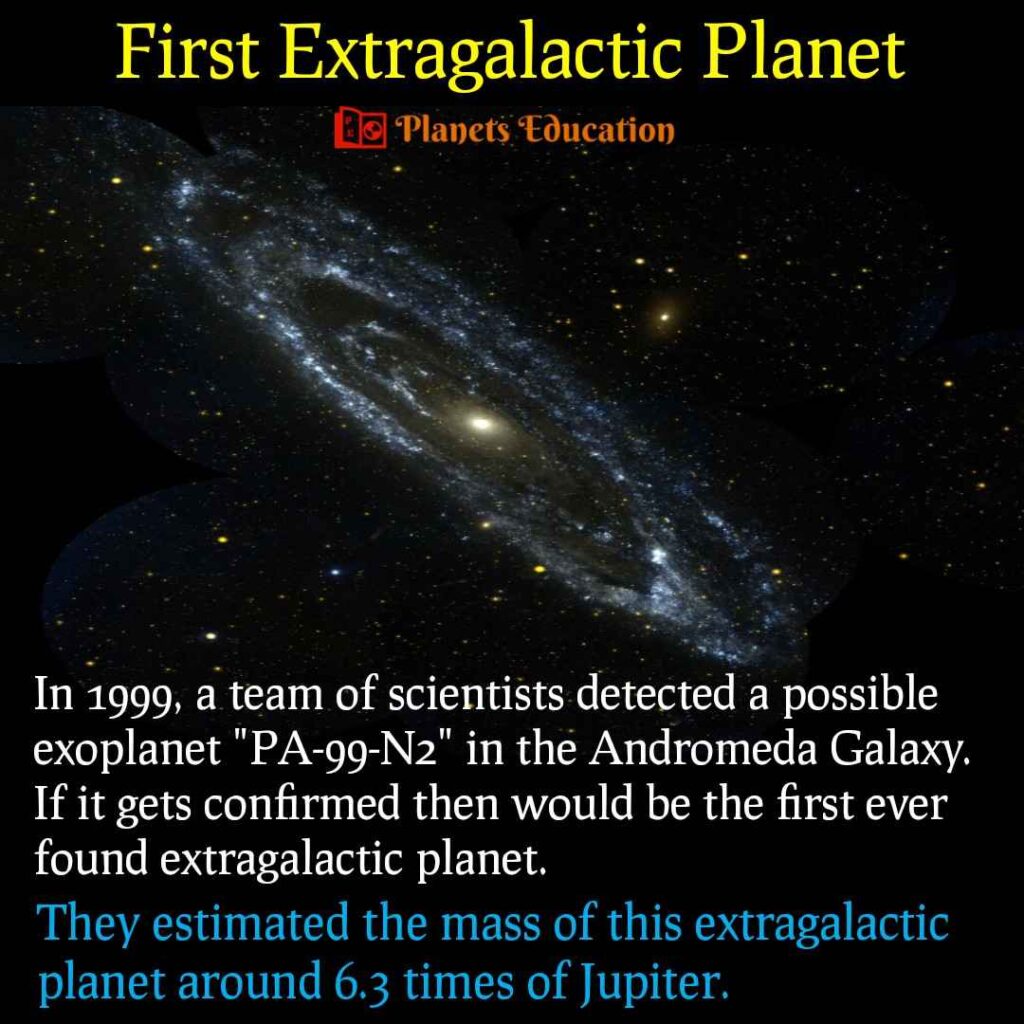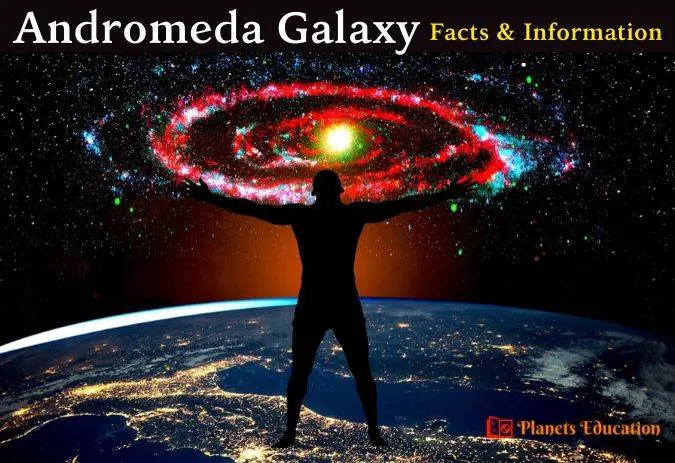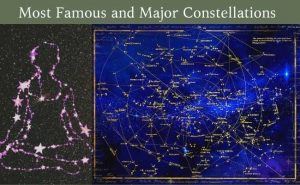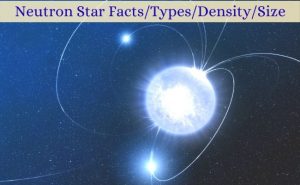The Andromeda Galaxy is a type of barred spiral galaxy, located in the Andromeda Constellation. The distance of Andromeda is about 2.5 million light-years away from us.
Andromeda is also known as “Messier 31, M31, or NGC 224” and it is the nearest major galaxy to Milky Way and Earth.
| Andromeda Galaxy exists in the Andromeda Constellation. |
According to an expectation of scientists, the Andromeda would collide with our galaxy Milky Way in around 4 billion years and this merging would form a giant elliptical galaxy.
The Andromeda is the largest galaxy in the Local Group (Local Group is a group of around 55 galaxies, including Milky Way, Andromeda, and other large galaxies).
| Must Read:- LARGEST GALAXY IN THE UNIVERSE IC 1101 |
Here in this article, we have mentioned some of the interesting Andromeda Galaxy Facts and Information, hope you will get some knowledge and be amazed after reading it:
Facts about Andromeda Galaxy
From the largest galaxy in the local group to Andromeda galaxy planets, many astonishing facts and information is mentioned here:
Largest Galaxy in Local Group
The Local Group is a group of around 55 galaxies, in which Andromeda is the largest galaxy. The Local Group has a diameter of around 10,000,000 light-years, whereas the diameter of Andromeda is around 220,000 light-years.
Our galaxy “Milky Way” is the 2nd largest in Local Group and “Triangulum Galaxy” is the 3rd largest in Local Group.
- Read here to know about:- 20 Special Milky Way Galaxy Facts.
Large but less massive than Milky Way
Though Andromeda is the largest galaxy in the Local Group but has a low mass compared to the Milky Way galaxy.
Some previous research shows that Andromeda is around 25% to 50% more massive compared to Milky Way. But according to some research groups in 2018 and 2019 estimated that the Milky Way galaxy is more massive compared to Andromeda.
The current calculation based on the dynamical mass measurements shows that the mass of the Andromeda Galaxy is around 1.6 ×1042 kg.
Whereas the currently estimated mass of the Milky Way is around 3.0 × 1042 kg, which is around 2 times more than Andromeda. It is because of Milky Way contains more dark matter that makes it more massive.
Supermassive Blackhole at the core
According to scientists, most galaxies have a black hole at their center. Andromeda has a very dense and compact cluster of stars at its center (core).
In 2005 NASA’s Hubble Space Telescope found some mysterious blue light coming from these star clusters orbiting the supermassive black hole in the Andromeda Galaxy (M31).
The approximate mass of this supermassive black hole is around 140 million solar masses. Whereas the mass of the Sagittarius A* (supermassive black hole at Milky Way core) is around only 4 million solar masses.
Andromeda collision with Milky Way
It has been estimated that Andromeda Galaxy will collide with our Galaxy Milky Way in about 4 billion years. As it is approaching Milky Way at about 110 km/sec (68 miles/sec). After the collision, it will merge and may form a giant elliptical galaxy.
As the sun orbits the milky way galaxy at a speed of around 225 km/sec. So considering the relative speed Andromeda is approaching our solar system (including earth) with a speed of around 300 km/sec.
What would be the effect of this collision with our planet earth or solar system, is currently unknown.
Andromeda’s distance from earth
Scientists have used several methods to estimate the distance of Andromeda from the earth.
In 2003, scientists used the I-SBF method (infrared surface brightness fluctuations) and estimated the distance around 2.57 ± 0.06 million light-years away from us.
In 2005, a TRGB method (Tip of the Red Giant Branch) is used and found an estimated distance of around 2.56 ± 0.08 million light-years away.
And after using some other methods and calculating, astronomers estimated the average distance of the Andromeda Galaxy from the earth is 2.54 ± 0.11 million light-years.
Andromeda Galaxy Planets
The extragalactic planets or extragalactic exoplanets are located outside of the Milky Way. But the most distant known planets are “SWEEPS-11” and “SWEEPS-04”, which are around 27700 light-years away from us and exist in the Milky Way.

We humans have not been able to detect directly even our farther milky way planets. But in 1999, a team of scientists detected a possible exoplanet “PA-99-N2” in the Andromeda Galaxy.
They detected this extragalactic planet “PA-99-N2” by using the gravitational lensing method and estimated the mass around 6.3 times of Planet Jupiter.
If it gets confirmed then would be the first-ever found extragalactic planet. Once it gets confirmed, then we may hope to get Andromeda galaxy planets pictures.
It has Satellite Galaxies
Like some planets have natural satellites (moons), Andromeda also has some satellite galaxies that revolve around the galaxy. Andromeda has around 20 known satellite galaxies (dwarf galaxies).
Messier 32 (M32) and Messier 110 (M110) are the two best-known satellite dwarf galaxies of Andromeda. Our Milky Way also has some satellite galaxies.
Andromeda can be seen naked eye
Andromeda is the most distant object outside of Milky Way that we are able to see with the naked eye. (I think it is one of the best Andromeda Galaxy Facts).
It is the only known spiral galaxy that can be seen naked eye from the earth. All you need is a proper good spot on moonless nights or use an amateur telescope to see it.
It has 460 Globular Clusters
Globular clusters are compact groups of stars in a spherical shape that orbit a galactic core. The Andromeda Galaxy has almost 460 globular clusters. These globular clusters can have several millions of stars in them.
Mayall II also known as Globular One (G1) is one of the most massive globular clusters of Andromeda.
This was some information about Galaxy Andromeda with some interesting facts and information, like Andromeda Galaxy Planets, its collision, size, shape, and distance, and many others.
Related Articles:-




